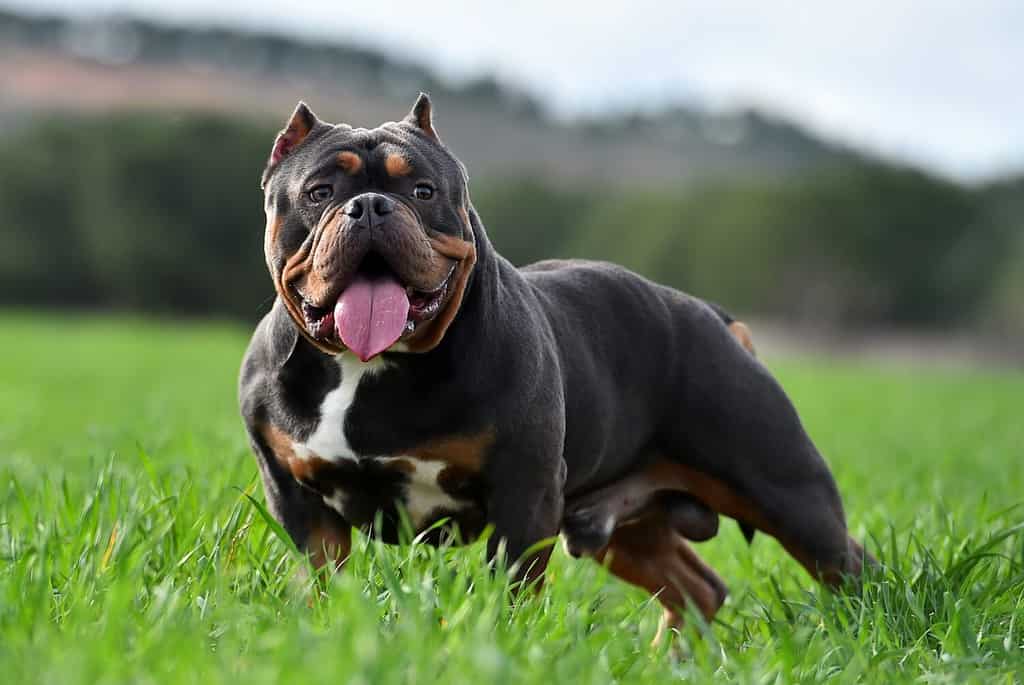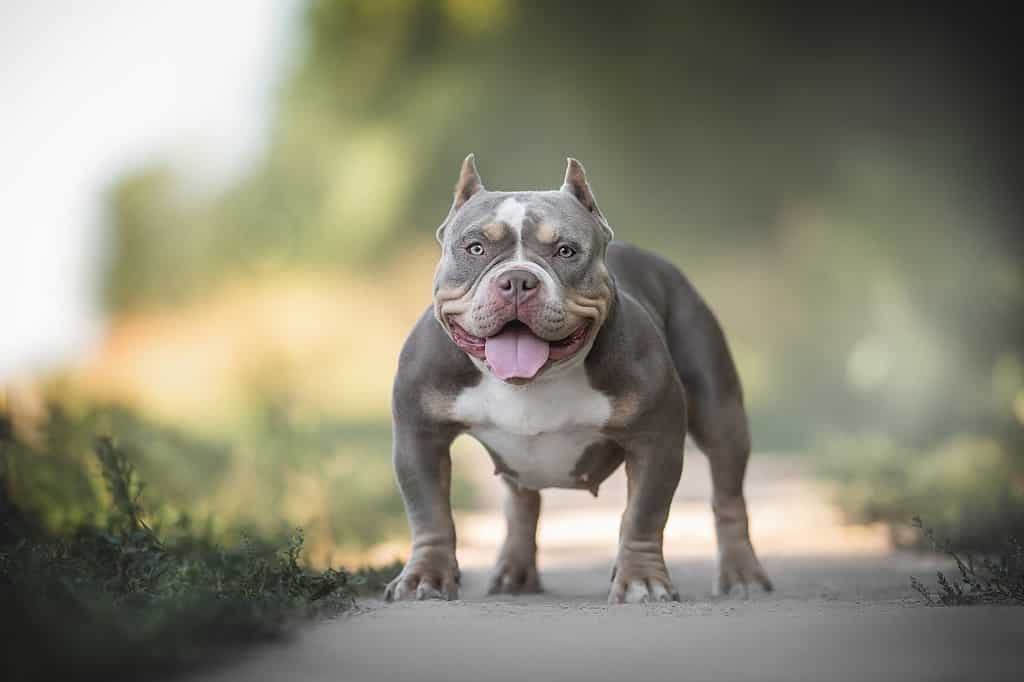The American bully is becoming a more and more popular dog as time goes by and with great reason. While American bullies can look tough on the outside, these pups are generally affectionate sweethearts with a wonderful temperament. However, understanding how to approach training an American bully is important, because these dogs can be a bit challenging to get under control.
American bullies are incredibly muscular, powerful dogs, capable of all sorts of shenanigans. Taking the time to learn how to train your bully is important because they’re strong enough to get into trouble when left untrained. This article will paint a clear picture of how to best train your American bully, including breed specs, a timeline, steps to training, tips, and common pitfalls. For a comprehensive guide to training your beautiful American bully, read on!
What Breeds Are in an American Bully?

These dogs come in four sizes and are loads of fun.
©Christine Reisner/iStock via Getty Images
The name “American bully” is often thought to mean either American bulldog or American pit bull. However, American bullies are not the same as either of those breeds! The American bully is a cross between Staffordshire terriers and American pit bulls. The breed originated around the 1980s, so these dogs are pretty new to the scene.
Are American Bullies Hard to Train?

A dog’s history impacts its trainability, just like its temperament. Socialization in the early years plays a big role in a dog’s trainability later on. American bullies are also sometimes bred for fighting, which makes them harder to train once retired.
©alberto clemares exposito/Shutterstock.com
While trainability can vary significantly from dog to dog, American bullies are thought of as somewhat challenging breeds to train. These dogs are intelligent and loyal, but they are notoriously stubborn. This means that training has to be executed in a way that is both interesting and trust-building for the dog.
For first-time dog owners, the challenge of training an American bully can feel intimidating. However, there are proven methods for developing these dogs’ skills in a way that works for both the owner and the bully. With specific training practices in place, you will very likely be able to develop a well-trained and gentle American bully.
How Smart is an American Bully?
American bullies are extremely intelligent! Their challenges in training are born from their intelligence, not their lack thereof. American bullies are almost too smart for their own good and are known to push back on their owners a bit. With patience, creativity, and resilience, however, you can surely train your American bully.
American Bully Training Timeline

As is the case with
all dogs
, starting young is an effective way to ensure quick training.
©Liudmila Bohush/Shutterstock.com
As is the case with most dogs, the exact training timeline will vary from pup to pup. Individual characteristics vary significantly from American bully to American bully and, therefore, it’s difficult to pin down an exact timeline for training success.
However, if you’re adopting an American bully puppy, here are some potential times that you can use as benchmarks while training your dog. Keep in mind that, if you adopt an older American bully, it’s likely that your timeline will be slower.
Potty training
If you’re potty training an American bully puppy, it can take up to six months for the breed to be fully potty trained. Consistent training and positive reinforcement will warrant faster results. It’s easy to “let things slide” when your pup is young and cute, but you’ll want to be disciplined about this! Begin training your puppy between 6-12 weeks old so that your pup is potty trained quickly.
Basic commands
Basic commands such as sit and stay vary in terms of timeline. However, the recommended evolution of training basic commands is as follows, according to this article on American bully milestones:
- “Sit: Teach them to sit to stay calm and focused.
- Stay: Once they master sitting, train them to stay put, gradually increasing duration and distractions.
- Down: Progress from sit to down, rewarding them for lying down.
- Come or Here: Use treats to teach them to come when called, gradually increasing distance and reducing treat dependency.”
Overall mellowing
American bullies are extremely active breeds, and it can be hard to know when their puppy behavior is simply bad behavior. You should expect your bully to mellow by age 2, though some hyper pups take an additional two years to calm all the way down. However, good training throughout their youth will promote good behavior despite hyperactivity.
Steps to Training a Well-Behaved Bully

©alberto clemares exposito/Shutterstock.com
Training any dog can feel like an intimidating task, especially if you’re starting with a rambunctious, lovable puppy! Don’t worry. You won’t need to be too hard on your pup. The biggest ways to make an impact on American bullies are consistency and positive reinforcement.
While each owner may take a slightly different approach, here are the basic steps for training your American bully.
1. Master potty training.
The first step is to make sure that your puppy doesn’t use the bathroom in the house. As was discussed in the prior section, you’ll want to begin potty training your American bully between 6-12 weeks of age. However, some individual pups will not be developmentally ready for potty training until they’re a bit older. If your training isn’t working, it’s alright to wait a bit.
To effectively potty train your bully, start by feeding your pup at regular times. This gets your dog’s body organized to be able to process food predictably, laying a great foundation for a good potty training schedule. Start taking your dog outside 15-30 minutes after they have eaten. Supervise potty breaks and reward the dog when they use the bathroom outside.
2. Use positive reinforcement for basic commands.
American bullies respond very well to positive reinforcement for basic commands. As opposed to having toys taken away or being shouted at, American bullies (and all dogs) respond better when they are rewarded after doing something correctly.
You can utilize treats, as well as a clicker, for training your bully to do basic commands. As suggested earlier in this article, it’s recommended that you teach your bully to sit first, then stay, then lie down, and finally, to come. However, you may find that some of the timelines of these commands overlap a bit, and that’s alright.
3. Socialize, socialize, socialize.
American bullies are wonderful, loyal dogs. However, without proper socialization, they can develop some poor habits when meeting other people and other dogs. Particularly in events where your dog is rescued from a fighting background, it’s necessary to develop positive socialization techniques.
These dogs are very smart, and other dogs serve as an important part of their enrichment. Playing socially can help to decrease your pup’s overall hyper energy. They benefit greatly from spending time in social settings. However, one caveat to this is that you’ll need to wait until your pup is vaccinated to get them socialized. It’s not safe for other dogs to be exposed to the bites of unvaccinated puppies.
4. Leash train.
This is an often overlooked element of training that is really important for the American bully. American bullies are exceptionally strong, so their version of a leash tug can be pretty forceful! Start training your dog from an early age to walk appropriately on a leash.
You’ll use a similar methodology as you used during the basic command training for your leash training. When your dog is walking appropriately on a leash, reward them with positive reinforcement through treats or clicks. Utilize basic commands such as stay and sit during walks to help reinforce their training.
Expert Tips for American Bully Training

American bullies can be stubborn, but utilizing these expert tips will help you instill great patterns into your pup.
©alberto clemares expósito/iStock via Getty Images
While it’s easy to understand the basics of good training, in-practice it can be a lot more complicated. Here are some expert tips for training your American bully.
Keep a good diet.
Interestingly enough, a good diet is a really important part of potty training your pup effectively. Without a healthy diet, they may use the restroom too much or too little. Work with your veterinarian to establish a healthy diet for your bully’s size and age so that you have a good foundation for your potty training.
Vary your tone of voice.
American bullies are super smart. If you constantly speak to them in the same tone of voice, they will get bored! Mix up your speech patterns with them to keep them interested in you.
Timing is everything.
Clicker training your dog is a great way to precisely train your pup. Respond with an immediate click when the behavior is good, and your dog can easily make an association between the behavior and the reward. They’ll get the reward of the sound and the treat, and they’ll have more clarity in what went right.
Small bursts make an impact.
These active dogs can get distracted. Keep training bursts short and consistent. Don’t train for more than 10 minutes at a time, or you’ll lose your dog’s focus. Small, intense bursts of training will be more effective than lazy, undisciplined training.
Develop trust with your pet.
American bullies are so smart that they are capable of questioning authority. However, the more they trust you, the more they’ll listen to you. Play with your puppy regularly in addition to training them. If you’re just bossy, they may not want to listen! But if you’re their friend, they will likely be more responsive.
Common Pitfalls When Training an American Bully
There are a few common pitfalls to consider while you’re training your American bully. Here are the top three:
1. Getting impatient.
It’s easy to lose your patience when you’re training a rambunctious, stubborn pup. However, losing your cool is not going to help your training plan. If you find yourself losing patience, end the training session so that you don’t respond negatively to your loyal (but misbehaving) pup. It can be difficult, but remind yourself that it’s hard to learn new things!
2. Using negative reinforcement.
Related to losing your patience, negative reinforcement is not an effective way of training your American bully. It can be easy to snap at your dog vocally, but negative reinforcement should never be used during training sessions. If you’re finding yourself getting frustrated, give yourself and your pup a break from the hard work. Take some time to cool off and play.
3. Neglecting enrichment activities.
Your American bully is a smart dog, and they need plenty of toys and activities to stay stimulated. Dogs without adequate stimulation are known to get into trouble! Equip your home with plenty of enrichment, including feeding toys, balls, and more. Play with your pup and challenge them with new skills once the basics are learned. Your American bully loves to solve problems! If they don’t have any appropriate problems to solve… they’ll start causing their own!
The Takeaways
Training an American bully can feel intimidating, but with positive reinforcement and a whole lot of patience, you can successfully get your pup on good behavior. From potty training to leash training, it’s important that your bully has a grasp of the basics before heading on to more complicated tricks. However, once you’ve established trust, your dog is going to love getting to know all sorts of things.
The photo featured at the top of this post is © STILLFX, Good Focused/ via Canva.com
Thank you for reading! Have some feedback for us? Contact the AZ Animals editorial team.






